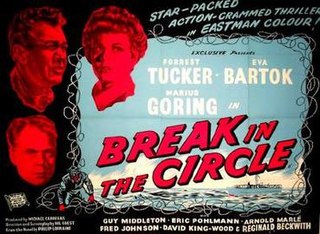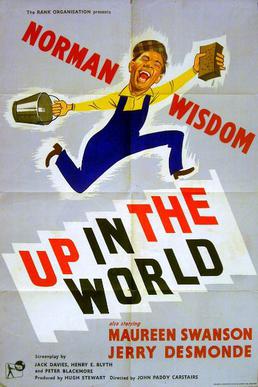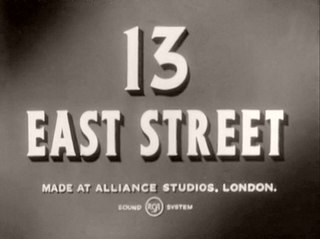
Just William's Luck is a 1947 British comedy film directed by Val Guest and starring William Graham, Garry Marsh and Jane Welsh. It was written by Richmal Crompton and Guest, based on Crompton's Just William series of books. Crompton was impressed with the film and wrote a novel Just William's Luck based on the events of the film. The following year a second film, William Comes to Town, was made.

Dry Rot is a 1956 British comedy film directed by Maurice Elvey, and starring Ronald Shiner, Brian Rix, Peggy Mount, and Sid James. The screenplay is by John Chapman, adapted from his 1954 Whitehall farce of the same name.

Break in the Circle is a 1955 British crime film directed by Val Guest and starring Forrest Tucker, Eva Bartok, Marius Goring and Guy Middleton. It was written by Guest based on the 1951 novel The Break in The Circle by Robin Estridge. Doreen Carwithen composed the score for the film.

A Matter of Murder is a 1949 British second feature ('B') crime film directed by John Gilling and starring Maureen Riscoe, John Barry, Charles Clapham, Ian Fleming and John Le Mesurier.

Up in the World is a 1956 black and white comedy film directed by John Paddy Carstairs and starring Norman Wisdom, Maureen Swanson and Jerry Desmonde. It was written by Jack Davies, Henty Blyth and Peter Blackmore, and produced by Rank.

Whispering Smith Hits London is a 1952 British second feature ('B') mystery film directed by Francis Searle and starring Richard Carlson, Greta Gynt and Herbert Lom. The screenplay was by John Gilling. It was released in the United States by RKO Pictures.

The Case of Charles Peace is a 1949 British crime film directed by Norman Lee and starring Michael Martin Harvey, Chili Bouchier and Valentine Dyall. The screenplay was by Lee and Doris Davison, based on the real-life Victorian murderer Charles Peace.

What the Butler Saw is a 1950 British second feature ('B') comedy film directed by Godfrey Grayson and starring Edward Rigby, Henry Mollison and Mercy Haystead. The screenplay was by A.R. Rawlinson and E. J. Mason, from an original story by Roger and Donald Good. It was made by Hammer Films.

To Dorothy a Son is a black and white 1954 British comedy film in the form of a farce directed by Muriel Box and starring Shelley Winters, John Gregson and Peggy Cummins. It was written by Peter Rogers based on the 1950 play To Dorothy, a Son by Roger MacDougall. It was distributed in America by RKO Pictures in January 1956.
Three Steps to the Gallows is a 1953 British second feature crime film directed by John Gilling and starring Scott Brady, Mary Castle and Gabrielle Brune. It was written by Paul Erickson and Gilling, and released in the US by Lippert Pictures as White Fire.

Darby and Joan is a 1937 British drama film directed by Syd Courtenay and starring Peggy Simpson, Ian Fleming, Tod Slaughter and Mickey Brantford. It was written by Courtenay based on the 1888 novel Darby and Joan by Rita. The film was a quota quickie, made at Rock Studios, Elstree, for release by MGM.

Death Is a Number is a 1951 British second feature ('B') horror film directed by Robert Henryson and starring Terence Alexander, Lesley Osmond and Peter Gawthorne. It was written by Charles K. Shaw.

Hangman's Wharf is a 1950 British second feature ('B') crime film directed by Cecil H. Williamson and starring John Witty, Genine Graham and Campbell Singer. It was written by John Beldon and Williamson based on Beldon's 1948 BBC radio serial Hangman's Wharf.

Naked Fury is a 1959 British crime thriller directed by Charles Saunders and starring Reed De Rouen, Kenneth Cope and Leigh Madison. It was written by Guido Coen and Brock Williams.

Landslide is a 1937 British drama film directed by Donovan Pedelty and starring Jimmy Hanley, Dinah Sheridan and Jimmy Mageean. It was written by Pedelty and David Evans.

Night Was Our Friend is a 1951 British second feature ('B') drama film directed by Michael Anderson and starring Elizabeth Sellars, Michael Gough and Ronald Howard. It was written by Michael Pertwee based on his 1951 play of the same name. The title references a line from Virgil's epic poem The Aeneid.

Death Goes to School is a 1953 British second feature ('B') mystery film directed by Stephen Clarkson and starring Barbara Murray, Gordon Jackson and Pamela Alan. It was written by Maisie Sharman and Clarkson based on the 1952 novel Death in Seven Hours by Stratford Davis, and was made at Merton Park Studios.

Counterspy is a 1953 British second feature comedy thriller film directed by Vernon Sewell and starring Dermot Walsh, Hazel Court and Hermione Baddeley. An accountant comes into possession of secret papers sought by both the government and a spy ring.
Room to Let is a 1950 British second feature ('B') historical thriller film directed by Godfrey Grayson and starring Jimmy Hanley, Valentine Dyall and Constance Smith. It was adapted by John Gilling and Grayson from the BBC radio play by Margery Allingham, broadcast in 1947.

13 East Street is a 1952 British second feature ('B') crime thriller film directed by Robert S. Baker and starring Patrick Holt, Sandra Dorne and Sonia Holm. It was written by John Gilling, Carl Nystrom and Baker and produced by Tempean Films.


















